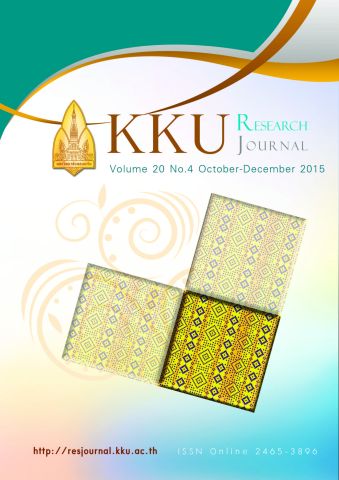Optimal parameters in precipitation hardening of 6061 aluminium alloy using box-behnken design
Main Article Content
Abstract
Precipitation hardening process is important to increase the hardness of 6061 aluminium alloy. In order to achieve the desired hardness, this process has several controlled parameters including solution soaking temperature, solution soaking time, aging temperature and aging time. The identification of each appropriate parameter is important in the precipitation hardening process of aluminium alloy. Because there has been no method or exact pattern, therefore this research work applies the response surface methodology with Box-Behnken design to determine these appropriate parameters. The experimental result is found that there are three factors significantly affecting on the hardness obtained from the precipitation hardening process. The experimental data is well fit a quadratic model due to high coefficient of determination (R2=0.92). When this regression model is taken to construct the three-dimensional surface response plot and the contour plot, it is found that the optimum condition is the solution treatment time of 5 hours and 18 minutes, aging temperature of 181C and the aging time of 10 hours which yield the maximum predicted Vicker hardness of 132.5 HV.
Article Details
References
[2] Chandler H. Heat treater’s guide : practices and procedures for nonferrous alloys. Ohio, Materials Park; 1996.
[3] Cole GS, Sherman AM. Lightweight materials for automotive applications. Journal of Materials Characterization. 1995; 35(1): 3-9.
[4] Edwards GA, Stiller K, Dunlop GL, Couper MJ. The precipitation sequence in Al-Mg-Si alloys. Acta Metallurgica. 1998; 46(11): 38933904.
[5] Esmaeili S, Lloyd DJ. Modeling of precipitation hardening in pre-aged Al-Mg-Si (Cu) alloy. Acta Materialia. 2005; 53: 5257-5271.
[6] Ozturk F, Sisman A, Toros S, Kilic S, Picu RC. Influence of aging treatment on mechanical properties of 6061 aluminum alloy. Journal of Materials and Design. 2010; 31: 972-975.
[7] Demir H, Gunduz S. The effects of aging on machinability of 6061 aluminum alloy. Journal of Materials and Design. 2009; 30: 1480-1483.
[8] Boehm H. Influence of precipitation hardening on the mechanical properties of hardened Al-Si alloy. Acta Metallurgica. 1963; 1(5): 369-389.
[9] Habashi F. Alloy : preparation, properties, application. New York, Wiley-VCH; 1998.
[10] Halild D, Suleyman G. The effect aging on machinability of 6061 aluminum alloy. Journal of Materials and Design. 2008; 30: 1480-1483.
[11] Satirajinda M. Nonferrous metals. Bangkok. Chulalongkorn University. 2000. Thai.
[12] Box GP, Behnken DW. Some new three level designs for the study of quantitative variables. Technometrics. 1960; 2(4): 455-475.
[13] Tekindal MA, Bayrak H, Ozkaya B, Genc Y. Box-Behnken experimental design in factorial experiments: the importance of bread for nutrition and health. Turkish Journal of Field Crops. 2012; 12(2): 115-123.
[14] Kaewploy S, Meengam C. Determination of optimal parameters for diffusion bonding of semi-solid casting aluminium alloy by response surface methodology. MATEC web of conferences. 2015; 26: 1-5.
[15] ASM Handbook committee. ASM Handbook : volume 4: Heat Treating; 1991.
[16] American society for testing and material. Annual book of ASTM standard: aluminum and magnesium, Vol 02.02. Easton; 1998.
[17] John VB. Introduction to engineering material. London, Palgrave Press; 2003.
[18] Montgomery DC, Runger GC, Hubele NF. Engineering statistics. New York,John Wiley & Sons Inc; 2006.
[19] Montgomery DC. Designing and analysis of experiments. New York, John Wiley & Sons Inc; 2000.
[20] Balasubramanian M. Application of Box–Behnken design for fabrication of titanium alloy and 304 stainless steel joints with silver interlayer by diffusion bonding. Journal of Materials and Design. 2015; 77: 161-169.
[21] Hassan AM, Bataineh OM, Abed KM. The effect of time and temperature on the precipitation behavior and hardness of Al–4wt % Cu alloy using design of experiments. Journal of Materials Processing Technology. 2008; 204: 342-349.
[22] Saravanan I, Perumal AE, Vettivel SC, Selvakumar N, Baradeswaran A. Optimizing wear behavior of TiN coated SS 316L against Ti alloy using Response Surface Methodology. Journal of Materials and Design. 2015; 67: 469-482.
[23] Swamy GJ, Sangamithra A, Chandrasekar V. Response surface modeling and process optimization of aqueous extraction of natural pigments from Beta vulgaris using Box-Behnken design of experiments. Journal of Dyes and Pigments. 2014; 111: 64-74.

